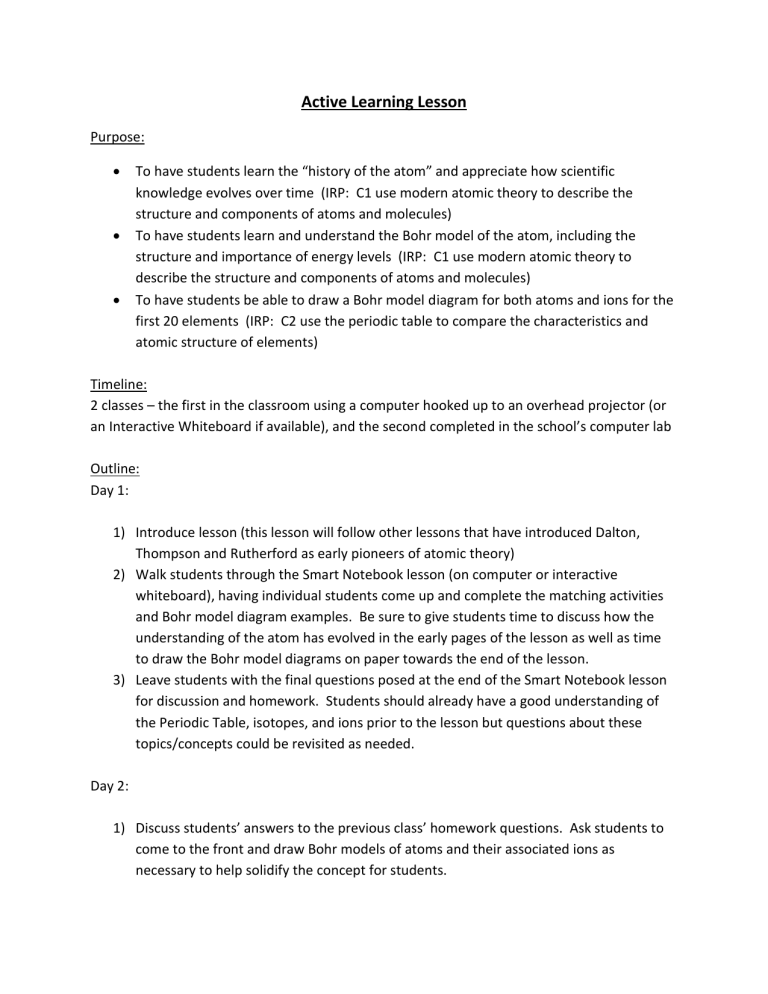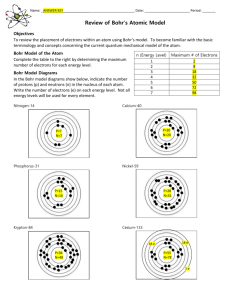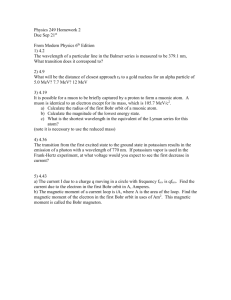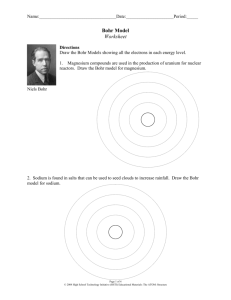Active Learning Lesson

Active Learning Lesson
Purpose:
To have students learn the “history of the atom” and appreciate how scientific knowledge evolves over time (IRP: C1 use modern atomic theory to describe the structure and components of atoms and molecules)
To have students learn and understand the Bohr model of the atom, including the structure and importance of energy levels (IRP: C1 use modern atomic theory to describe the structure and components of atoms and molecules)
To have students be able to draw a Bohr model diagram for both atoms and ions for the first 20 elements (IRP: C2 use the periodic table to compare the characteristics and atomic structure of elements)
Timeline:
2 classes – the first in the classroom using a computer hooked up to an overhead projector (or an Interactive Whiteboard if available), and the second completed in the school’s computer lab
Outline:
Day 1:
1) Introduce lesson (this lesson will follow other lessons that have introduced Dalton,
Thompson and Rutherford as early pioneers of atomic theory)
2) Walk students through the Smart Notebook lesson (on computer or interactive whiteboard), having individual students come up and complete the matching activities and Bohr model diagram examples. Be sure to give students time to discuss how the understanding of the atom has evolved in the early pages of the lesson as well as time to draw the Bohr model diagrams on paper towards the end of the lesson.
3) Leave students with the final questions posed at the end of the Smart Notebook lesson for discussion and homework. Students should already have a good understanding of the Periodic Table, isotopes, and ions prior to the lesson but questions about these topics/concepts could be revisited as needed.
Day 2:
1) Discuss students’ answers to the previous class’ homework questions. Ask students to come to the front and draw Bohr models of atoms and their associated ions as necessary to help solidify the concept for students.
2) Take the class down to the computer lab and explain that our purpose is to solidify what we have learned about the Bohr model and practice drawing Bohr models online.
3) Establish computer lab expectations with students and hand out guided study worksheet (see below) to help focus students’ attention on the task
4) Have students first visit: http://highered.mcgraw-hill.com/sites/007299181x/student_view0/chapter16/bohr_atom_interactive.html# and click on the shockwave interactive Bohr model link. Encourage them to investigate the model and fill in their worksheet as they go. Circulate to answer questions and guide students.
5) Next have students go to: http://www.classzone.com/books/earth_science/terc/content/investigations/es0501/es0501page04.cfm
and have them work to construct Bohr model diagrams online. They can then fill in the accompanying worksheet section.
6) At the end of class, students will discuss the final question at the end of the worksheet and then write a response at home for homework.
Assessment:
Nothing formal (formative only). Students will be assessed on Bohr model diagrams through quizzes/tests at a later date
BOHR MODELS (part II) Name: _
Block: _
The plan: Today we’ll be using some online resources to re-enforce what we learned about the
Bohr atom last class and to help us draw some Bohr model diagrams.
Bohr’s energy levels:
A.
Open your web browser and go to http://highered.mcgraw-hill.com/sites/007299181x/student_view0/chapter16/bohr_atom_interactive.html#
Then click the link that says: The Bohr Atom (51.0K)
B.
Click the ‘introduction’ tab in the page that pops up and use it to answer the following questions (on a separate sheet of lined paper):
1) How was Bohr’s view of the atom different from any other that came before him?
2) What determines the wavelengths of light that can be given off by an atom of a specific element?
C.
Click on the ‘interactive’ tab and “play” with it for a little bit. Use the ‘How To’ tab to help you if necessary.
D.
Click on the ‘Exercises’ tab and follow the directions. Answer all questions on a separate sheet of lined paper. Discuss your answers with the person at the computer next to you.
Feel free to check the ‘Solutions’ tab, but not until you’re finished talking with your partner. We’ll be discussing your answers together next class.
Bohr Models:
A.
Take your browser to: http://www.classzone.com/books/earth_science/terc/content/investigations/es0501/es0501page04.cfm
and click through the instructions – feel free to watch the tutorial to remind yourself how it’s done!
B.
Using the interactive atom builder, build and then draw the following atoms and ions:
A Phosphorus atom A Magnesium atom p___ n___ p___ n___
A Chlorine ion p___ n___
A Magnesium ion p___ n___
Further Discussion and Homework:
Discuss with the person next to you what you liked and didn’t like about working with the two activities online. Did they help you understand the concepts better? If so how? What didn’t you like about them? Write a paragraph about each of the online activities summarizing what they were about and what you think the good and bad things about each of them were.






